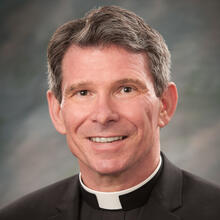This year, I had something of a Norma Desmond moment. Remember in Sunset Boulevard, when Joe Gillis (William Holden) recognizes the aging star? He thoughtlessly jabbers, “You’re Norma Desmond. You used to be in silent pictures. You used to be big.”
The star, played by Gloria Swanson, responds, “I am big. It’s the pictures that got small.”
My Norma Desmond moment came at a funeral luncheon, which had been moved from our parish hall to the upstairs of the old Knights of Columbus hall, now a banquet venue. There, at the end of the room, was the same raised dais upon which my thespian career began. It looked so small! I wondered how those magnificent casts of old ever found space to tread its timbers. My mind retreated half a century, before the Knights had grown too old to climb into their second story dance hall for their annual Christmas Nativity Pageant. It was produced by the legendary team of Joe and Helen Hickel. Helen played the piano, and Joe was the director. Joe had a sport coat, plaid, the only man in town who did, certainly the only Knight. Helen wore a necklace of turquoise. If that’s not Hollywood, what is? Every year, Joe and Helen marshalled three thespian transactions: casting, rehearsal and performance.
I dreamed of playing Joseph. I’d stand in the line, trying to look chaste and wise and available. But I was never cast as the saint. And how I longed to play one of the three kings. My brother Harold was twice cast as a wise man. He got to wear a crown of gold wrapping paper and a dressing gown, borrowed from Bill Witcraft, our neighbor. He had oil money. Harold entered, porting a treasure chest, as the rest of us sang about tar in the Orient. I never understood what tar had to do with Christmas. It must be very precious in the Orient.
I was always cast as one of the numberless, nameless shepherds. I might have played an angel, wearing a taffeta gown trimmed in tinsel, but in my hometown of Ellinwood, heaven had a glass floor. No male angels. Shepherds got a stick and a towel to wrap around their head. It would take a Norma Desmond to look glamorous with a towel around one’s head. Heaven knows I tried.
I longed for my breakout moment. One year, we briefly discussed adding a little drummer boy. Saint Pat’s, in Great Bend, did that. But that was the county seat, where lots of men wore plaid sport coats and women sported turquoise jewelry. The big city might take liberties with the script, but at St. Joe’s, in Ellinwood, we stuck to good old Matthew and Luke. No “pa rum pum pum pum” for us.
Still, when we were all assembled on that stage—however it may have shrunk over the years—there came a mystical moment when the assembled cast, along with the audience, broke into Silent Night. The Baby Jesus, his mother Mary and Joseph, were surrounded by kings, angels and humble shepherds. It was a feast for eyes of faith.
Love longs to look, to gaze upon the beloved. As the old English song put it, “Drink to me only with thine eyes, and I will pledge with mine.” To love another is to delight in gazing upon the other. That’s the mystery that we celebrate at Christmas.
The Son comes among us that we may gaze upon God. In the words of the preface, which we pray at Christmas, “For on the feast of this awe-filled mystery, though invisible in his own divine nature, he has appeared visibly in ours; and begotten before all ages, he has begun to exist in time.”
The gaze is a fundamental act of the Catholic faith, essential to it throughout the year. We don’t simply proclaim a gospel in which God became visible. We celebrate a liturgy in which God is made seeable in sacrament, in which we gaze upon God. In the English words of Saint Thomas Aquinas’ Latin hymn.
Down in adoration falling,
Lo! the sacred Host we hail,
Lo! O’er ancient forms departing
Newer rites of grace prevail;
Faith for all defects supplying,
Where the feeble senses fail.
The Christmas crèche is the ingenious gift of the great Catholic poet, Saint Francis of Assisi. Reformers might rail against sacred images, but, at Christmas, the world turns Catholic, for a spell, as little children are brought forward so that they might gaze upon the Christ child. They peer amidst candles, bells and incense, against all of which the reformers ranted.
Love wants to look. It desires to gaze upon the beloved. Indeed, when we talk of our future possession of God in heaven, we speak of the beatific vision, the gaze, whose intensity and depth can never be exhausted.
The Virgin of Nazareth, the first disciple, is the great exemplar of the gaze. In the gospels, she doesn’t speak on this silent night, but we are told that she gazed deeply because she “kept all these things, reflecting on them in her heart” (Lk 2:19). The gaze of the lover is a light, revealing a truth about the beloved that no one else can see. Look at medieval and renaissance paintings of the nativity. The Catholic gaze is everywhere; the Christ Child is surrounded by those who long to look.
Gazing is effortless when one is in love, and, should love need strengthening, it is done through the gaze. First we must quiet ourselves. And then, we look again. Love can be rekindled. In our nation, our homes, our hearts. Gaze. See the mystery. Love again.








